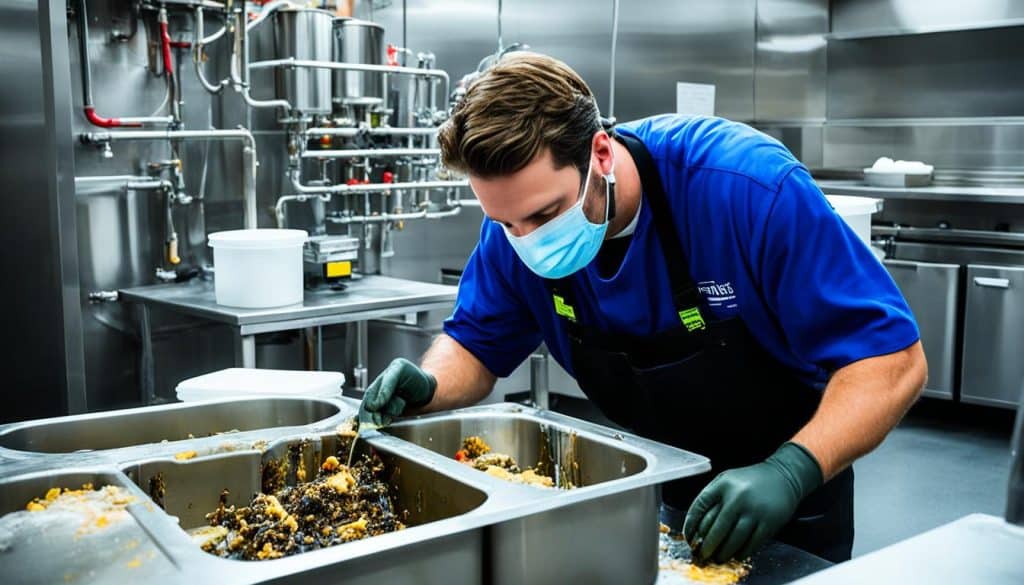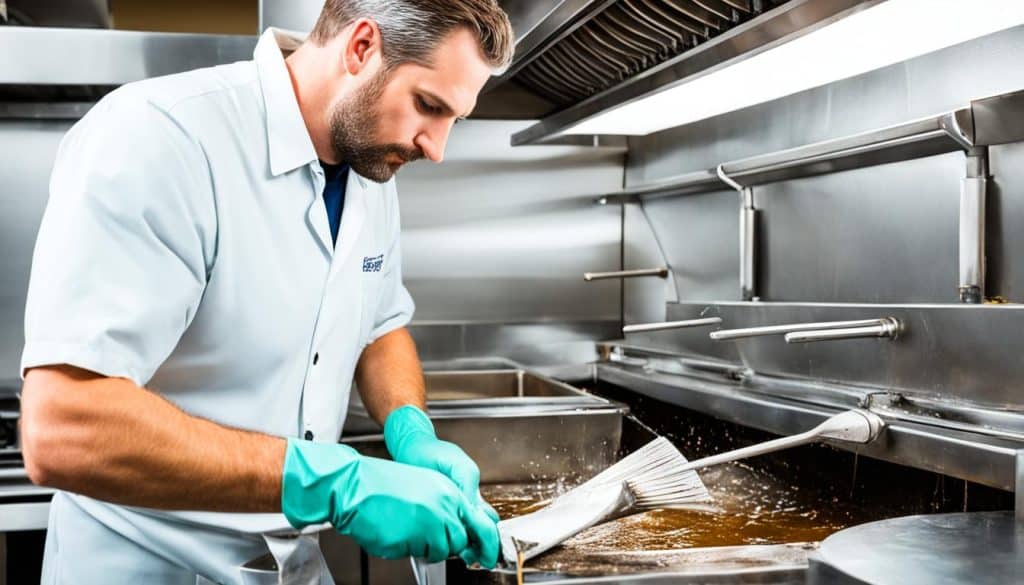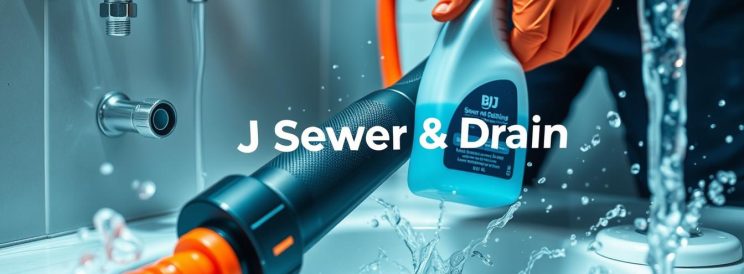Ever thought about saving money and keeping your kitchen clean by doing your own grease trap maintenance? You just need the right DIY grease trap cleaning supplies. What Tools Do I Need for DIY Grease Trap Cleaning?
Grease traps are crucial in commercial kitchens. They keep things running smoothly and follow local rules. Doing it yourself can save money and feel rewarding. You’ll need special tools like liquid core samplers, vacuum pumps, and protective gear for a good job.
Key Takeaways
- Understanding the importance of regular grease trap maintenance.
- Recognizing the cost-saving benefits of DIY grease trap cleaning.
- Essential tools include liquid core samplers and specialized vacuum pumps.
- Ensuring proper disposal of waste in line with local regulations.
- The significance of protective gear for safe grease trap cleaning.
Introduction to DIY Grease Trap Cleaning
Keeping your grease trap clean is key for following rules and keeping your kitchen clean. Learning about grease trap maintenance tools helps you do this job better. It saves money and lets you control the upkeep.
Why Regular Maintenance is Important
Regular upkeep stops clogs, which can cause bad smells and expensive fixes. Using the right tools for cleaning grease traps keeps it running well. It also stops backups. Plus, it’s often required by law.
Benefits of Doing It Yourself
Cleaning your grease trap yourself can save money. It lets you control how clean your kitchen stays. With the right tools, like strong scrapers and efficient pumps, it’s easy. In Chicago, J Sewer & Drain Plumbing Inc. offers great help if you need it.
Essential DIY Grease Trap Cleaning Tools
Keeping grease traps clean is key to avoiding clogs and keeping them running well. You need the right DIY grease trap cleaning equipment for a good clean. The liquid core sampler is a must-have. It shows you how much fats, oils, grease, and solids are in the trap.
This helps you know when and how to clean it. A scraper is also a must. It’s great for getting rid of solid grease and buildup from the trap walls. This makes cleaning the whole surface easier.
A vacuum pump is also crucial. It sucks out the waste, leaving the trap clean. This is important for getting rid of unwanted stuff.

Water hoses that can handle the job are needed for a good rinse. They make sure no debris is left behind. Don’t forget rubber gloves and protective gear. They keep you safe from waste and bad smells while you clean.
With these DIY grease trap cleaning equipment, you’re ready to clean effectively.
Incorrect Heading (Duplicate)
Cleaning a grease trap by yourself might seem hard at first. But, with the right tools and some guidance, it’s doable. Regular maintenance helps avoid clogs and backups, saving you money and trouble.
Choosing the right DIY tools for cleaning is key. Without the proper equipment, you might struggle to get the job done right. This preparation helps keep your kitchen running smoothly and clean.
It’s important to know how each tool works and how to use it. From liquid core samplers to scrapers and vacuum pumps, each tool is crucial. Learning how to use them makes cleaning easier and more effective.
The next sections will explore specific tools in detail. They’ll show you how to use them and why they’re important. Doing it yourself not only keeps your grease trap in good shape but also gives you a sense of pride.
Liquid Core Sampler: The First Step
The liquid core sampler, also known as a sludge judge, is a key tool for DIY grease trap cleaning. It helps you understand what’s inside your grease trap. You can see the layers of fats, oils, grease, solid waste, and water.
Purpose and Usage
The main job of the liquid core sampler is to show you the layers in your grease trap. By taking a core sample, you can see how much cleaning is needed. This helps you pick the right tools for a deep clean.
Using it right means lowering it into the grease trap and pulling it out slowly. This way, you don’t mess up the layers.
Types of Liquid Core Samplers
There are many types of liquid core samplers out there. They come in different lengths and materials for all kinds of grease traps. Choosing the right one is key for getting accurate samples.
Whether you choose a plastic or stainless steel sampler, think about its durability and how easy it is to use.

Using the right grease trap cleaning tools, starting with the liquid core sampler, makes cleaning easy and effective. It keeps your grease trap in top shape.
Scraper and Vacuum Pump
Two key items in a DIY grease trap cleaning kit are the scraper and vacuum pump. The scraper helps remove fats, oils, and grease from the trap’s walls. It’s crucial for a deep and effective clean.
Once the scraper has done its job, the vacuum pump steps in. It sucks out the loosened waste and water. This leaves the trap clean and ensures waste is disposed of correctly. It’s important to use these tools safely to avoid accidents. Proper handling keeps you safe and ensures a good clean.
Additional Grease Trap Cleaning Equipment
Having the right tools for cleaning a grease trap is key. You need more than just scrapers and vacuum pumps. A variety of extra equipment is needed for a complete and safe clean. A well-planned cleaning routine keeps your grease traps working well for longer.
Durable Water Hose
A tough water hose is a must for rinsing the grease trap. It helps get rid of leftover grease after scraping. Choose a hose with adjustable pressure to avoid damaging the trap. The right hose makes sure your grease trap is clean and ready for more use.
Rubber Gloves and Protective Gear
High-quality rubber gloves are a must for protecting your hands. They keep you safe from harmful waste and give a good grip. Also, wear gas masks or nose plugs to avoid bad smells. Staying safe lets you focus on cleaning well.
With these extra tools, cleaning your grease trap is easier and safer. Choose durable, quality tools for effective and easy maintenance.


